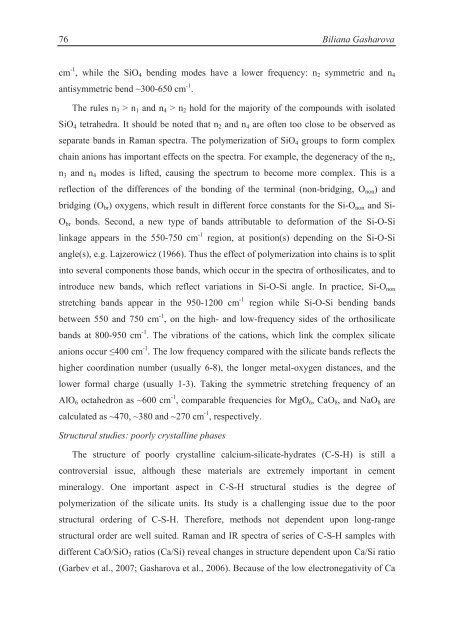instrumental techniques applied to mineralogy and geochemistry
instrumental techniques applied to mineralogy and geochemistry
instrumental techniques applied to mineralogy and geochemistry
You also want an ePaper? Increase the reach of your titles
YUMPU automatically turns print PDFs into web optimized ePapers that Google loves.
76<br />
Biliana Gasharova<br />
cm -1 , while the SiO 4 bending modes have a lower frequency: n 2 symmetric <strong>and</strong> n 4<br />
antisymmetric bend ~300-650 cm -1 .<br />
The rules n 3 > n 1 <strong>and</strong> n 4 > n 2 hold for the majority of the compounds with isolated<br />
SiO 4 tetrahedra. It should be noted that n 2 <strong>and</strong> n 4 are often <strong>to</strong>o close <strong>to</strong> be observed as<br />
separate b<strong>and</strong>s in Raman spectra. The polymerization of SiO 4 groups <strong>to</strong> form complex<br />
chain anions has important effects on the spectra. For example, the degeneracy of the n 2 ,<br />
n 3 <strong>and</strong> n 4 modes is lifted, causing the spectrum <strong>to</strong> become more complex. This is a<br />
reflection of the differences of the bonding of the terminal (non-bridging, O non ) <strong>and</strong><br />
bridging (O br ) oxygens, which result in different force constants for the Si-O non <strong>and</strong> Si-<br />
O br bonds. Second, a new type of b<strong>and</strong>s attributable <strong>to</strong> deformation of the Si-O-Si<br />
linkage appears in the 550-750 cm -1 region, at position(s) depending on the Si-O-Si<br />
angle(s), e.g. Lajzerowicz (1966). Thus the effect of polymerization in<strong>to</strong> chains is <strong>to</strong> split<br />
in<strong>to</strong> several components those b<strong>and</strong>s, which occur in the spectra of orthosilicates, <strong>and</strong> <strong>to</strong><br />
introduce new b<strong>and</strong>s, which reflect variations in Si-O-Si angle. In practice, Si-O non<br />
stretching b<strong>and</strong>s appear in the 950-1200 cm -1 region while Si-O-Si bending b<strong>and</strong>s<br />
between 550 <strong>and</strong> 750 cm -1 , on the high- <strong>and</strong> low-frequency sides of the orthosilicate<br />
b<strong>and</strong>s at 800-950 cm -1 . The vibrations of the cations, which link the complex silicate<br />
anions occur 400 cm -1 . The low frequency compared with the silicate b<strong>and</strong>s reflects the<br />
higher coordination number (usually 6-8), the longer metal-oxygen distances, <strong>and</strong> the<br />
lower formal charge (usually 1-3). Taking the symmetric stretching frequency of an<br />
AlO 6 octahedron as ~600 cm -1 , comparable frequencies for MgO 6 , CaO 8 , <strong>and</strong> NaO 8 are<br />
calculated as ~470, ~380 <strong>and</strong> ~270 cm -1 , respectively.<br />
Structural studies: poorly crystalline phases<br />
The structure of poorly crystalline calcium-silicate-hydrates (C-S-H) is still a<br />
controversial issue, although these materials are extremely important in cement<br />
<strong>mineralogy</strong>. One important aspect in C-S-H structural studies is the degree of<br />
polymerization of the silicate units. Its study is a challenging issue due <strong>to</strong> the poor<br />
structural ordering of C-S-H. Therefore, methods not dependent upon long-range<br />
structural order are well suited. Raman <strong>and</strong> IR spectra of series of C-S-H samples with<br />
different CaO/SiO 2 ratios (Ca/Si) reveal changes in structure dependent upon Ca/Si ratio<br />
(Garbev et al., 2007; Gasharova et al., 2006). Because of the low electronegativity of Ca













